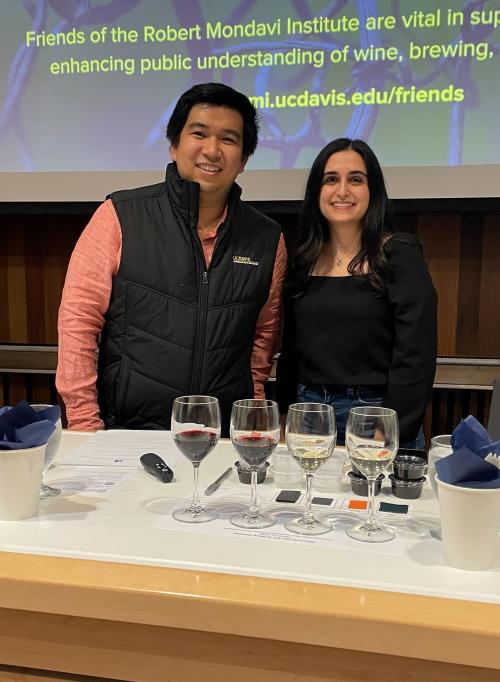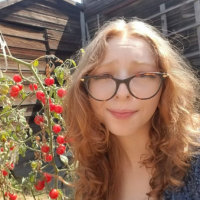
The Art, and Science, of Wine Tasting
Have you ever wondered how winemakers and sommeliers seem better at tasting wine than everyone else? It’s not magic. It’s exposure. Over time, they sharpen their senses and learn to taste with intention.
At a special student-led event, UC Davis Ph.D. candidates Arpa Boghozian and Lik Xian showed us that anyone can develop these skills. With the right approach, we can train our senses to experience wine on a whole new level.

Meet the Experts
For Arpa and Lik, this tasting was a full-circle moment. They first collaborated on a wine sensory trial in 2021 in the Oberholster lab.
Arpa Boghozian, from Orange County, is pursuing her Ph.D. and studying how red blotch disease impacts grape quality. Arpa has a deep connection to Armenia's ancient winemaking traditions, she shares her name with the Arpa River, which flows past the world’s oldest winery.
Lik Xian, a 3rd year Ph.D. candidate from Singapore, was drawn to UC Davis by his passion for food. After earning his food science degree in 2021, a post-grad internship at Black Stallion Winery solidified his path in the wine industry. His current research focuses on how wildfire smoke impacts grapes.
Sensory 101
Lik used a bakery to explain sensory perception. Before you even see the pastries, the warm, yeasty aroma of bread fills the air, triggering memories. If that bread burns, the smell shifts to something sharp and bitter, signaling something is wrong. Without even tasting it, your nose has built an expectation of flavor. Wine works the same way. By linking smell, taste, and texture to familiar references we can train ourselves to notice the smallest details.
To sharpen our perception of taste and texture Arpa and Lik kicked off the session with a hands-on sensory training exercise. We used sensory standards, reference points for specific taste, smell, or texture, to help us break down and better understand what we experience in a glass.
We started with two contrasting standards, one sweet and one sour. The sweet sample was slightly sweeter than the sweetest dry wine, helping us gauge sugar levels. For the sour sample, Lik had us imagine biting into a lemon as we sipped, locking the puckering sensation into our sensory memory.
Next, we explored texture through two more standards. The first was slightly heavier than water, highlighting how body and weight shape mouthfeel. The other was astringent and drying, showcasing tannins, the compounds that create the drying sensation in young red wines. Lik compared it to eating an unripe banana, where tannins latch onto saliva proteins, leaving your mouth parched.
Training Our Noses
Have you noticed how food tastes dull when you’re congested? To prove how essential smell is to taste, we popped gummy bears into our mouths while pinching our noses. At first, they were flavorless. But as soon as we let go, the fruit flavors exploded. Arpa explained this was the retronasal effect, how smell enhances taste.
Next, we trained our noses using four scent standards found in wine. The red fruit standard smelled of bright, juicy cherries and strawberries. The dark fruit evoked deeper, richer aromas of dark currant and blackberries. The tropical fruit standard burst with vibrant notes of passion fruit, peaches, and pineapple, contrasting with the butterscotch sample, which exuded a warm, caramel-buttery aroma. By engaging our sense of smell and making mental connections, we learned to recognize these aromas in wine.
The Texture of Wine
Arpa and Lik guided us through another activity, this time focused on wine’s tactile sensations. We ran our fingers over silk, suede, sandpaper, and velcro, mapping these textures to wines, some smooth and elegant, others grippy and astringent. Just as each fabric has its unique feel, wines have their own dynamic texture.
There are two main types of dynamic touch sensations in wine. Grippy, a rough, dry feeling with little surface smoothness or slip, and adhesive, a sticky, pulling sensation, like glue. Since our gums and lips have touch receptors but no taste receptors, this is the best spot to assess texture.
Let’s Taste!
With our new sensory training complete, it was time to taste. Arpa and Lik encouraged us to go beyond flavor and focus on how the wine felt in our mouths. “Move the liquid between your gums and lips,” they instructed, “and focus on the initial sensation. Does the wine feel grippy or adhesive?”
As we sipped, we put our new skills to the test, calling out "apple!" "tropical fruit!" “sandpaper!” “adhesive!” We confidently identified Sauvignon Blanc, Chardonnay, Pinot Noir, and Cabernet. Many were surprised at how much sharper their perception had become.
This event showed that wine appreciation is about tuning into your senses. Next time you pour a glass, take a moment to swirl, sniff, and sip with purpose. You might be surprised by what you discover.

Kaylianne Jordan is a junior transfer student studying Viticulture and Enology at UC Davis. She has a background in culinary arts and a passion for sustainable farming and enjoys exploring the connections between agriculture, winemaking, and community. Outside of college, she loves trying out new recipes, discovering local food spots, and spending time with friends in the outdoors.
